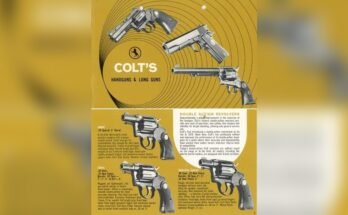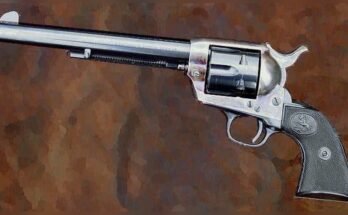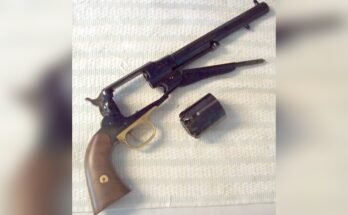If you’ve ever felt the sharp kick of a snub-nose revolver, you know controlling recoil can be a real challenge. But what if you could turn that powerful jump into smooth, steady shots?
Understanding how to control recoil on your snub-nose revolver isn’t just about comfort—it’s about accuracy and confidence every time you pull the trigger. You’ll discover simple, effective techniques that help you tame the recoil, so your shooting feels natural and precise.
Ready to take control and improve your aim? Keep reading, because mastering recoil is easier than you think.

Snub-nose Revolver Basics
The snub-nose revolver is a popular choice for personal defense and concealed carry. Its compact size makes it easy to carry and quick to draw. Understanding the basics helps control recoil better. This section explains the essential features and common challenges of snub-nose revolvers.
Key Features
Snub-nose revolvers have short barrels, usually 2 to 3 inches long. This design makes them lightweight and easy to hold. They often have a small grip to fit comfortably in one hand. Most models hold five or six rounds. The simple mechanism ensures reliability and easy maintenance.
Common Challenges
Short barrels cause more felt recoil compared to longer guns. The small grip offers less control and can increase muzzle flip. Light weight means the gun moves more during shooting. These factors make it harder to keep shots accurate. Learning to manage these challenges improves shooting comfort and precision.
Proper Grip Techniques
Proper grip techniques are essential to control recoil on a snub-nose revolver. A firm and steady hold reduces muzzle rise and improves accuracy. Small changes in your grip can make a big difference in how the gun feels and performs. Below are key grip methods to help manage recoil effectively.
Two-handed Grip
Use both hands to hold the revolver firmly. Your dominant hand wraps around the grip tightly. The support hand wraps around the dominant hand, covering the exposed part of the grip. This creates a stronger hold and spreads the recoil force. Keep thumbs pointed forward and side by side for better control.
Finger Placement
Place your trigger finger on the trigger with steady pressure. Avoid jerking the trigger to prevent losing control. Rest your middle, ring, and pinky fingers around the grip. Do not wrap the pinky finger too far under the grip. Keep your fingers firm but relaxed to absorb recoil smoothly.
Wrist Positioning
Keep your wrists straight and firm, not loose or bent. A stiff wrist helps push the gun forward during recoil. Avoid letting your wrists collapse or bend backward. This maintains stability and reduces muzzle flip. Strong wrists help you stay on target for follow-up shots.
Stance And Body Position
Controlling recoil on a snub-nose revolver starts with your stance and body position. A strong stance helps absorb the gun’s kick. Your body acts as a solid base to manage recoil better. Proper positioning keeps you steady and ready for the next shot. Small adjustments make a big difference in control and accuracy.
Stable Footing
Stand with your feet shoulder-width apart. This stance provides balance and keeps you steady. Place one foot slightly forward for better weight distribution. Keep your knees slightly bent to absorb recoil. Avoid locking your legs to stay flexible. Stable footing prevents you from moving backward after a shot.
Body Alignment
Face your target squarely or turn slightly sideways. Align your shoulders with the gun’s barrel. Keep your chest up and lean slightly forward. This helps direct recoil into the ground. Keep your arms firm but not rigid. Proper body alignment reduces felt recoil and improves control.
Trigger Control Tips
Controlling recoil on a snub-nose revolver starts with good trigger control. The way you pull the trigger affects how much the gun moves. Focus on steady, smooth actions. This reduces recoil and helps you shoot more accurately. Here are key tips to improve your trigger control.
Smooth Pull
Pull the trigger slowly and evenly. A sudden pull causes the gun to jerk. This makes recoil worse. Keep your finger relaxed and press straight back. Imagine pressing a button gently. This helps keep the revolver steady. Practice this to build muscle memory. Smooth pulls lead to better shots.
Avoiding Jerks
Jerking the trigger makes the gun jump. This throws off your aim. Avoid snatching or yanking the trigger. Focus on a calm, controlled motion. Use your whole hand, not just your finger. Keep your grip firm but not tight. This balance reduces jerking. Training with dry fire drills can help. Stay patient and consistent to improve.
Breathing And Focus
Controlling recoil on a snub-nose revolver needs more than just physical skill. Breathing and focus play a key role in handling recoil well. They help keep your body steady and your mind clear. This makes shooting more accurate and comfortable.
Breath Control
Breath control is vital for steady shooting. Take a deep breath before you pull the trigger. Hold it for a moment to keep your body still. Exhale slowly after the shot. This reduces movement and helps you stay calm.
Breathing evenly stops sudden jerks. It also lowers your heart rate. This makes your aim more precise. Practice slow, deep breaths to build this habit. It will improve your control over recoil.
Mental Preparation
Mental focus sharpens your shooting skills. Clear your mind of distractions before shooting. Think about your stance, grip, and target. Visualize a smooth shot with no recoil issues.
Stay calm and confident. Anxiety makes your hands shake and increases recoil effect. Practice mental calmness through breathing exercises. A focused mind reacts better to the gun’s kick.

Using Recoil-reducing Accessories
Using recoil-reducing accessories helps control the sharp kick of a snub-nose revolver. These tools reduce the force felt in your hand. They make shooting more comfortable and improve accuracy. Choose the right accessory based on your shooting style and needs.
Grip Enhancements
Upgrading the grip is one of the easiest ways to reduce recoil. Soft rubber grips absorb some of the shock. Textured surfaces improve your hold and prevent slipping. Larger grips can spread recoil over a wider area of your hand. Custom grips fit your hand better for more control. These changes help keep the revolver steady during shooting.
Muzzle Devices
Muzzle devices attach to the end of the barrel. They redirect gases to reduce muzzle rise and recoil. A muzzle brake pushes gases sideways or upward to counter recoil. Compensators focus gases to keep the barrel level. These devices help keep your aim on target. Some models fit snub-nose revolvers and improve shooting comfort.
Practice Drills For Recoil Management
Practice drills are key to controlling recoil on a snub-nose revolver. Recoil can make shots less accurate. Training your body and mind helps manage it better. These drills build muscle memory and improve your shooting skills. Focus on steady grip, smooth trigger pull, and quick recovery after each shot. Regular practice leads to better recoil control and confidence.
Dry Firing Exercises
Dry firing means pulling the trigger without live bullets. It helps improve trigger control without recoil distraction. Use snap caps to protect the revolver’s firing pin. Stand in your shooting stance. Focus on a steady grip and smooth trigger press. Practice slowly and watch the front sight move. This builds muscle control and reduces flinching. Repeat often to develop consistent trigger habits.
Live Fire Training
Live fire training applies dry fire skills under recoil. Start with low-recoil rounds to ease into it. Keep your grip firm but relaxed. Focus on quick sight realignment after each shot. Shoot in controlled bursts, not rapid fire. Track your shot group to see improvement. This trains your body to handle recoil naturally. Consistent live fire practice improves control and accuracy.

Frequently Asked Questions
How Can Grip Affect Recoil Control On A Snub-nose Revolver?
A firm, consistent grip reduces muzzle rise and felt recoil. Use your dominant hand to hold the grip tightly. Support with your other hand if possible. This stabilizes the revolver and improves shot accuracy.
What Role Does Stance Play In Managing Recoil?
A balanced, forward-leaning stance helps absorb recoil energy. Position feet shoulder-width apart with knees slightly bent. This stance provides stability and control during rapid fire or follow-up shots.
Are There Specific Techniques To Reduce Recoil Effectively?
Yes, techniques like the push-pull method help. Push forward with the shooting hand while pulling back with the support hand. This counteracts recoil and keeps the revolver steady.
Does Ammunition Choice Impact Recoil On Snub-nose Revolvers?
Lighter loads with lower velocity produce less recoil. Choose ammunition that balances power and comfort. This makes shooting more manageable and increases accuracy for quick follow-ups.
Conclusion
Controlling recoil on a snub-nose revolver takes practice and focus. Grip the gun firmly but not too tight. Keep your wrist steady and use your body to absorb the kick. Practice shooting slowly to build control and confidence. Remember, small steps improve your skill over time.
Stay calm and consistent with your technique. Recoil will feel easier as you gain experience. Shooting safely and accurately becomes more natural with patience. Keep practicing, and your control will grow.



